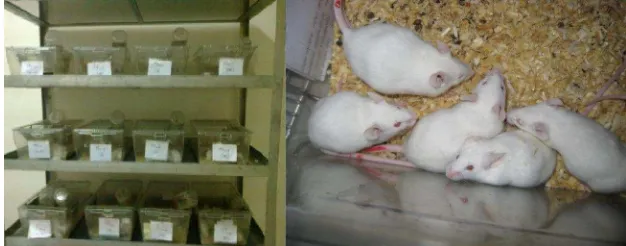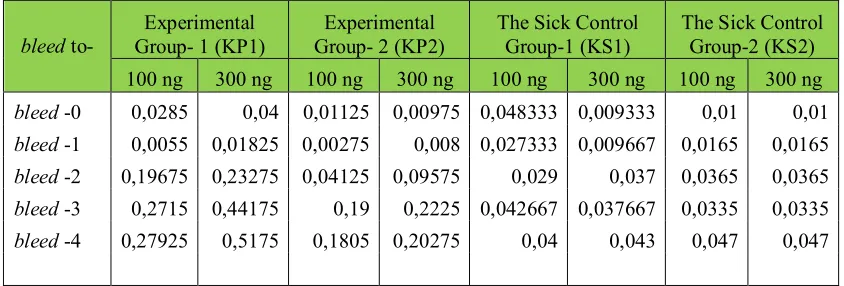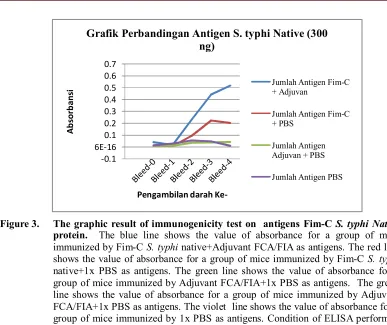C-14
PRODUCTION AND CHARACTERIZATION OF ANTI FIM-C Salmonella typhi
NATIVE PROTEIN ANTIBODY IN DDY MICE
Muktiningsih Nurjayadia, Umar Hasana, Dea Apriyania, Fera Kurnia Dewia, Irma Ratna Kartikaa, Fernita Puspasarib, Dessy Nataliab
aDepartement of Chemistry, Mathematics and Science Faculty, State University of Jakarta, Indonesia
bBiochemistry Division, Department of Chemistry, Mathematics and Science Faculty, Bandung Institute of Technology, Indonesia
Abstract
Typhoid fever is a disease affect many people in developing countries including Indonesia. Prevention can be aided by vaccination to the bacteria; however it still needs further research. This research is aimed to determine the immunogenicity of fim-C native protein Salmonella typhi in vivo as a vaccine candidate in ddY mice. Experimental method is used in this research. This research used antigen of pure fim-C native recombinant protein from its previous research. The ddY mice are categorized into five groups, namely experiment group 1 (protein Fim-C+Freund's Complete/Incomplete Adjuvant), experiment group 2 (protein Fim-C S. typhi), control group 1 (FCA/FIA adjuvants), control group 2 (PBS1x), and normal group (PBS1x). The results showed that the ddY mice produced antibody response after subcutaneous injection of the Fim-C S. typhi native protein +adjuvant or without adjuvant. The antibody responses with Fim-C S. typhi native protein as antigen+adjuvant gave higher absorbans than the Fim-C antigen without adjuvant. It is also showed that the antibody titer from the first to fourth injection has gradually increased. These data showed that Fim-C S. Typhi native protein had higher immunogenicity. It is concluded that the Fim-C S. typhi native protein can be used as a potential recombinant vaccine candidate against typhoid fever.
Key words: Salmonella typhi, Typphoi Disease, Fim-C Salmonella typhi native Protein Antibody, Recombinant vaccine
INTRODUCTION
Typhoid fever is one of diseases suffered by most people in developing countries, including Indonesia. Typhoid fever is suffered ranging from children to adults. Typhoid fever is easily transmitted to human through food and drink contaminated by Salmonella typhi bacteria in the poor standards of environment hygiene. Typhoid fever happens in Indonesia with an average of 900,000 cases per year. The mortality rate is more than 20,000 cases or 91% of all cases ranging in the age of 3-19 years old. The mortality rate increases in every year [Crump and Mintz, 2010; Verry, 2011]. Thus serious action to prevent and overcome typhoid fever in Indonesia is highly needed.
proteins on Salmonella typhi can be potentially used as recombinant vaccine for typhoid fever prevention. Due to its higher level of safety, recombinant vaccine is chosen to be further developed rather than conventional non recombinant vaccine that uses attenuated virus.
In the prior research, researchers team from UNJ has succeeded in Fim-C Salmonella typhi gene cloning and sub-cloning on the cloning and expression vectors and its protein purification in both native form and inclusion bodies [Anggraeni R et al, 2012; Pratiwi E et al. 2013; Muktiningsih et al, 2013]. This research is aimed to determine the activity of Fim-C S. typhi recombinant protein in its native form as an antigen in mice ddY through immune response analysis. This information is very important in the development of the potential recombinant Fim-C S. typhi protein as candidate for recombinant vaccine to prevent typhoid fever in human.
RESEARCH METHOD
A. Production of anti Fim-C S. typhi antibodies
Production of anti Fim-C Salmonella typhi native antibodies consisted of preparation stage for mice ddY as animal test, preparation stage for Fim-C S. typhi Native recombinant protein as antigene, immunization and antibodies production, and mice serum/anti-FimC S. typhi antibodies isolation [Harlow and Lane, 1988; Deutsher, 1990; Noer, et al., 1992; Jennings, 1995].
A.1. Preparation stage for mice ddY as animal test
Production of anti Fim-C antibodies was conducted in LABTIAP (Agricultural Industry Technology Development and Biomedical Laboratory) BPPT-Serpong. The production of anti-Fim C S. typhi Native antibodies performed on 40 male mice ddY strains, age of 5-6 weeks and weigh of 17-24 grams. Mice were obtained from PT Biofarma Bandung. Mice were maintained in cages placed in the treatment room with temperature condition of 20-240C and 20-70% humidity. Treatment room was made sound-proof and impermeable to keep the air pressure lower than the surrounding so the odor will not come out. Every testing was conducted in different room. 4-8 mice are placed in individual cages of polycarbonate (with stainless steel cover) with size of 41,5x27x15 cm3 each. The individual cages were arranged in 3 level stainless steel racks. During the conditioning process, mice were weighed on day 0, day 3 and day 5. Cage, food, health, and activity checks were also done regularly. The conditioning process is as long as a week.
A.2. Preparation stage for Fim-C S. typhi Native recombinant protein as antigene
As many as 25-100 µg Fim-C S. typhi native protein from previous results was disolved witth PBS 1x bufer in Eppendorf 1,5 mL tube to have a total volume of 100-250 µL. Freund’s complete adjuvant (FCA) or Freund’s incomplete adjuvant (FIA) were added with ratio 1:1. Then performed homogenized mix using vortexs until the mix turned white [Harlow and Lane, 1988; Jenings, 1995].
A.3. Immunization and Antibodies Production
Immunization was carried out on the backs of mice in the front section near head subcutaneously as much as 2-3 points for one-time injection. On the first immunization 20 µg Fim C S. typhi native protein that has been prepared as an antigen was mixed with Freund’s complete Adjuvant. One week after the first injection researchers took blood sample from mice’s eyes to prepare the serum. One week after the first injection researchers conducted boosting with 40 g Fim-C mixed with Freund’s incomplete Adjuvant. The second and third boosting were conducted with the 80 g Fim-C after one week of the second and the third injections to obtain the optimal antibody amount [Harlow and Lane, 1988; Noer, 1992].
A.4. Mice serum/anti-FimC S. typhi antibodies isolation
Blood sample from mice’s eyes was collected on tubes of centrifuges sterile. Blood sample was incubated at temperature of 370C for 30-60 minutes to a visible separation between serum and platelets. Centrifugation was carried out for 10 minutes with the speed of 5000 g at a 4 oC. Clear liquid/serum was taken out and kept in Eppendorf. Then the serum was stored in –200C [Harlow and Lane, 1988].
B. Characterization of anti Fim-C S. typhi Native antibodies by ELISA
Antibodies used in the formation analysis of anti-FimC S. typhi antibodies was mice serum from Bleed I-Bleed IV. Formation analysis of anti-Fim-C protein S. typhi antibodies from day 0 (pre-immune serum) until the 6 weeks was obtained by Enzyme Link Immunosorbant Assay (ELISA).
RESULT AND DISCUSSION
A.Production of anti-Fim-C S. typhi native Antibodies
The results of animal conditioning process and pre-immune serum collection process
[image:4.612.148.461.261.384.2]Health, weight, diet, and physical condition checks and observation during the conditioning process showed good result. This was demonstrated by the increase in weight on average 3-5 gram/mice. The observed physical condition of feathers and motion also showed patterns of activity that corresponds to standard conditions. The conditioning place and picture of test animals are presented in figure 1.
Figure 1. The conditioning place and picture of test animals. Mice are grouped into 5 cages. Every cages containing 8 mice for the experimental groups (KP) and the sick control group (KS) and containing 4 mice for normal group (KN).
The retrieval results of pre-immune serum from sinus orbitalis eyes produced 0,5-1 mL blood/mice and it was 0,2-0,5 mL serum of the total blood samples. Serums were stored in frezer with temperture -20oC for further purposes.The pupose of takingpre-immune serum is as a negative control to the formation of anti Fim-C antibodies. This is aimed to ensure that there is no interaction occurs between Fim-C protein as antigene with mice antibodies before imunization.
The production results of anti-FimC S. typhi antibodies
Production of anti-FimC S. typhi native antibodies in experimental and control groups was performed in 6 weeks. The process consisted of the first imunization with 20 µg Fim C S. typhi native protein, boosting-1 with 40 µg Fim-C S. typhi native protein. Boosting-2 and boosting-3 were conducted by using 80 µg Fim-C S. typhi native protein. Each step gave a total amount serum 0,2-0,5 mL. After ELISA data was obtained with highest absorbance values, in the sixth week researchers collected blood samples of 4 mice from experimental groups by the maximum as much as 5-10 mL. The blood was prepared to serum containing anti-Fim C S. typhi antibodies as many as 2-4 mL/mice.
B. Characterization of anti Fim-C S. typhi native antibodies by ELISA
group I (immunized by Fim-C S. typhi native Protein mixed with Freud complete/incomplete adjuvant-KP-1), experimental group 2 (immunized by Fim-C S. typhi native Protein without adjuvant-KP2), control group-1 (immunized by Freud complete/ incomplete adjuvant, KS1), control group-2 (immunized by 1x PBS buffer, KS-2), and normal group (immunized by 1x PBS buffer, KN). The result of development of antibodies formation from 4 mice ddY from each group are presented in table 1. While the analysis results of development formation of anti-Fim C S. typhi antibodies is presented in figure 2 and figure 3.
Table 1. The data values of absorbance on development anti Fim-C S. typhi native antibodies at experimental group (KP) and the sick control group (KS) at antigene concentration 100 ng and 300 ng
bleed to- Group- 1 (KP1) Experimental Group- 2 (KP2) Experimental The Sick Control Group-1 (KS1) The Sick Control Group-2 (KS2) 100 ng 300 ng 100 ng 300 ng 100 ng 300 ng 100 ng 300 ng bleed -0 0,0285 0,04 0,01125 0,00975 0,048333 0,009333 0,01 0,01 bleed -1 0,0055 0,01825 0,00275 0,008 0,027333 0,009667 0,0165 0,0165 bleed -2 0,19675 0,23275 0,04125 0,09575 0,029 0,037 0,0365 0,0365 bleed -3 0,2715 0,44175 0,19 0,2225 0,042667 0,037667 0,0335 0,0335 bleed -4 0,27925 0,5175 0,1805 0,20275 0,04 0,043 0,047 0,047
Based on the results of analysis on the development of formation anti-Fim C S. typhi antibodies by ELISA shown in Table 1 that Fim-C S. typhi native protein with or whithout adjuvants give satisfied immune response. This is shown by an increase absorbance values from Bleed 0-Bleed 4. The increase of color intensity or absorbance values showed increase in the amount of antibody titer that interacted with Fim-C S.typhi antigene. The blue color was from the oxidation TMB substrate (3,3’,5,5’-Tetramethylbenzidine) to 3,3',5,5'-tetramethylbenzidine diimine by Horse Redish Peroksidase enzyme which bounded to secondary antibodies. Color formation reaction was stopped by adding 50 µL H2SO4 and resulted yellow color and measured at wavelenghts 450 nm [Thermo scientific Biogen, 2013]
Data presented in table 1 or figure 2 and figure 3 give information that induction by protein Fim-C S. typhi Native +Adjuvant FCA/FIA as antigene produced higher antibodies than by protein Fim-C S. typhi Native+ PBS 1x. This is in accordance with the literature review stated that the Frued complete/incomplete adjuvant (FCA/FIA) can enhance the formation of immune response [Harlow and Lane, 1988; Fiorino et al, 2012; Moreno et al., 2013]. These results also provide information on specific characters of Fim-C S. typhi native protein that if recombinant protein mixed with adjuvants the resulting immune response will be higher than without adjuvants. The information is also essential that Fim-C S. typhi native protein without adjuvant can also provide a good immune response.
advantages [Harlow and Lane, 1988; Fiorino et al, 2012].
[image:6.612.104.513.129.451.2]Figure 3. The graphic result of immunogenicity test on antigens Fim-C S. typhi Native protein. The blue line shows the value of absorbance for a group of mice immunized by Fim-C S. typhi native+Adjuvant FCA/FIA as antigens. The red line shows the value of absorbance for a group of mice immunized by Fim-C S. typhi native+1x PBS as antigens. The green line shows the value of absorbance for a group of mice immunized by Adjuvant FCA/FIA+1x PBS as antigens. The green line shows the value of absorbance for a group of mice immunized by Adjuvant FCA/FIA+1x PBS as antigens. The violet line shows the value of absorbance for a group of mice immunized by 1x PBS as antigens. Condition of ELISA performed on serum dilutiom 100x and secondary antibodies dilution 5000x.
CONCLUSION AND SUGGESTION
Fim-C S, typhi Protein in native form has ben succesfully used as an antigen specific in production of anti Fim-C S. typhi antibodies in vivo in mice ddY. The generated formation of immune response is indicated by the color change of substrate after interaction between Fim-C S. typhi antigen with anti Fim-C S. typhi antibodies. From Bleed 1-Bleed IV, the establishment of spesific anti Fim-C S. typhi antibodies with Fim-C + adjuvant FCA/FIA as antigene gives higher immune response than without adjuvants. The result also provides information that Fim-C S. typhi Typhi protein has good nature of imunogenicity because it is able to make higher response immune without the addition of adjuvant and adjuvant FCA/FIA. So that it can be inferred that Fim-C S. typhi native Protein can be used as vaccine candidates.
Significant supporting data about vaccine’s standardized test and clinical trials for human are still needed to make recombinant protein molecules of Fim-C S. typhi native serve as a safe and inexpensive molecular vaccine. The information generated in this study could be made of the scientific basis for the further development of recombinant vaccines for typhoid fever in humans, especially in Indonesia.
-0.1 6E-16 0.1 0.2 0.3 0.4 0.5 0.6 0.7
Ab
so
rb
an
si
Pengambilan darah
Ke-Grafik Perbandingan Antigen S. typhi Native (300 ng)
Jumlah Antigen Fim-C + Adjuvan
Jumlah Antigen Fim-C + PBS
Jumlah Antigen Adjuvan + PBS
Anggraeni. R., Fera Kurnia Dewi, Irma Ratna Kartika, Fernita Puspasari, Muktiningsih Nurjayadi, Dessy Natalia. 2012. Cloning of Fim-C Salmonella typhi gene on pGEM-T easy vector to develop recombinant vaccine for typhoid Disease. Proceeding Gruber Soedigdo Lecture, 25 September 2012, Bandung, Indonesia.
Burrows, L. L. 2005. Weapons of Mass Refraction. Mol Microbiol; 57:878-888. Deutcher, P, M. 1990. Guide To Protein Purification, Methods In Enzymology, Vol. 182.
Harlow, E., dan D, Lane. 1998. Antibodies A Laboratory Manual. USA : Cold Spring Harbor Laboratory.
Jenings, V., M. 1995. Review of Selected Adjuvants Used In Antibody Production, ILAR Journal; 37, 3:119-132.
John A. Crump and Eric D. Mintz, 2010. Global Trends in Typhoid and Paratyphoid Fever. Invited article. Emerging Infections. CID 2010:50 (15 january). 241-246
Muktiningsih. 2005. Produk Gen CarA Salmonella Typhi Berukuran 42 kDa yang Dideteksi Dengan Antibodi Anti-Protein Fusi. Disertasi Program Pascasarjana, Institut Teknologi Bandung.
Muktiningsih.N., Yoni.F. Syukriani, Irma Ratna Kartika, Murni. S, Catur.D.A. 2009 The Fuction of Salmonella Typhi Reference Spot Bacteria With Molecular Weight 46.7 Kilodalton and Isoelectric Point 6.7. Proc. The first International Seminar on Science and Technology, UII-UKM-UMT, 24-25 January. Jogjakarta- Indonesia.
Muktiningsih.N, Endah Dianty Pratiwi, Ulfah Choiriyah, Fera Kurniadewi, Irma Ratna Kartika, Fernita Puspasari,Dessy Natalia. 2013. Purification and Characterization of Fim-C Salmonella typhi Recombinant Fusion Protein with size 31 kDa As Vaccine Candidate. Proc. The 2nd International Conference of The indonesian Chemical Society (ICICS-2). 22-23 October 2013. Jogjakarta-Indonesia. p.225-235.
Moreno-Eutimio MA, Tenorio-Calvo A, Pastelin-Palacios R, Perez-Shibayama C, Gil-Cruz C, Santiago R, Baeza I, Fernández-Mora M, Bonifaz L, Isibasi A,Calva E, López-Macías C., 2013. Salmonella Typhi OmpS1 and OmpS2 porins are potent protective immunogens with adjuvant properties. Immunology. Aug;139(4):459-71.doi: 10.1111/imm.12093.
Noer, A, S., Marzuki dan Allison, W., S,. 1992. Antipeptide Antibodies To The Carboxy Terminal and the DCCD Binding Region of Human Mithocondrial ATP Synthetase Beta Sub-Unit. Biochem, Biophys, Acta. 1099:123-130.
Thermo Scientific, Biogen, 2013
Verma, Shailendra Kumar1, Vandana Gautam1, Konduru Balakrishna2, and Subodh Kumar, 2009.Overexpression, Purification, and Immunogenicity of Recombinant Porin Proteins of Salmonella enterica Serovar Typhi (S. Typhi). J. Microbiol. Biotechnol. (2009), 19(9), 1034–1040 doi: 10.4014/jmb.0812.675 First published online 5 June 2009
Verry. 2011. Waspada Gejala Tifus, Segera Periksa Diri Anda!.
http://www.prodiakalimantan.com/artikel-kesehatan/100-waspadai-gejala-tifus-segera-periksakan-diri-anda.html (Diakses pada tanggal 3 Agustus pukul 21.35 WIB).
Yang Y, Wan C, Xu H, Wei H. 2013. Identification and characterization of OmpL as a potential vaccine candidate for immune-protection against salmonellosis in mice.
Vaccine. 2013 Jun 19;31(28):2930-6. doi: 10.1016/j.vaccine.2013.04.044. Epub 2013



